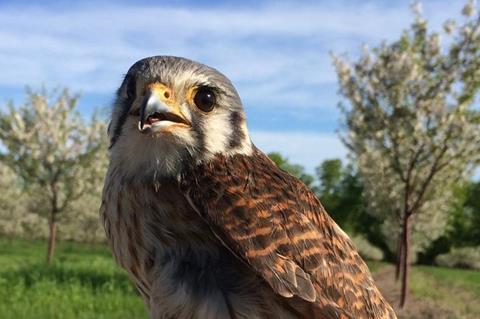The cherry harvest wrapped up months ago. But in northern Michigan, some growers are already anticipating the spring resurgence of a tiny raptor that could benefit next season’s crop.

The American kestrel is the smallest falcon in the U.S. As birds of prey, kestrels deter smaller birds that like to snack on farmers’ fruit. But new research suggests that these winged security guards may have an additional benefit: food safety.
That’s according to a study from Michigan State University, to be published Nov. 27 in the Journal of Applied Ecology.
“They’re cool to watch in flight,” said lead author Olivia Smith. They hover in mid-air as they scan the ground below for insects, mice and small birds.
Safer, healthier food
By shooing cherry-pecking birds away, kestrels also keep them from contaminating crops with their droppings, the new findings show.
The research could help farmers grow safer, healthier food that reaps more profits, the researchers said.
“It’s hard to keep birds out of crops,” said Smith, an assistant professor of horticulture and member of MSU’s Ecology, Evolution, and Behavior Program.
Growers have tried methods like nets, noise makers, scarecrows and sprays, but these approaches can be costly and don’t always work.
Crop losses
Even with control measures in place, sweet cherry growers in states such as Michigan, Washington, California and Oregon still lose anywhere from 5% to 30% of their crop to birds each year.
Hungry birds pose another problem: they poop. Some people worry that the mess they leave behind could be laced with pathogens that make people sick.

So the researchers decided to see if enticing predators to patrol orchards could help reduce the risks.
They focused on nest boxes installed in eight sweet cherry orchards in northern Michigan and found that kestrels — which rely on tree cavities and other existing crannies to raise their chicks — were quick to move in.
Then they took note of all the birds they could see or hear as harvest time drew near.
Scared off
The team found that birds such as robins, grackles and starlings were much less likely to visit orchards and gobble up fruit when kestrels were nesting nearby. By scaring away hungry visitors, kestrels reduced the likelihood of cherry damage more than tenfold.
But their presence had another benefit. The researchers also found fewer signs that birds were doing their business on the cherry trees. Kestrels were associated with a 3-fold reduction in droppings spotted on branches.
READ MORE: Disease experts upgrade sentinel chicken system to create forecast for West Nile virus
READ MORE: New super pest combines broad spectrum of microbes
“Certainly, kestrels poop too,” said senior author Catherine Lindell, associate professor emerita of Integrative Biology and a member of MSU’s Center for Global Change and Earth Observations.
But the number of fruit-eating birds they keep out of an orchard more than makes up for it, she added. Indeed, they found that cherry trees closer to the kestrel’s nest boxes were less likely to be dusted with droppings.
Foodborne disease
DNA analysis revealed that 10% of the droppings contained Campylobacter, a bacteria that commonly causes foodborne illness. Symptoms include diarrhea, fever and stomach cramps.
This doesn’t mean that your next bowl of cherries will give you a bellyache, the researchers said. None of the food-borne illness outbreaks caused by Campylobacter have been linked to cherries.
Likewise, Smith added, it may also be too early to blame birds for contaminated crops. Only one outbreak has been traced to birds, a 2008 Campylobacter outbreak caused by migratory cranes in pea fields in Alaska.
Fewer opportunities for transmission
But the research suggests kestrels could be a way to improve food safety in other crops that have been associated with outbreaks, such as leafy greens.
“They’re really good at keeping the amount of poop down,” Smith said. “That means fewer opportunities for transmission.”
“This won’t solve all the bird problems farmers face,” she added. One issue with depending on kestrels, for example, is that they are more likely to set up shop in some regions than others.
“But it’s a low-cost, low maintenance tool for growers to use in their bird management toolbox,” Lindell said.
Smith was supported by an EEB Presidential Postdoctoral Fellowship co-advised by Lindell and EEB faculty member Jen Owen. This work was also funded by a grant to Smith from the U.S. Department of Agriculture (2021-67012-35133).
CITATION: “Falcons Reduce Pre-Harvest Food Safety Risks and Crop Damage From Wild Birds,” Olivia M. Smith, Pedro A. P. Rodrigues, Sarah A. Groendyk, Olivia J. Utley, Ashley de Borchgrave d’Altena, Samantha Carbonell, Kayla L. Davis, Talia Swartout, Sofia Varriano, Niesa Kettler, Rinosh Mani, Shannon D. Manning, Jennifer C. Owen, William E. Snyder, and Catherine A. Lindell. Journal of Applied Ecology, Nov. 27, 2025. DOI: 10.1111/1365-2664.70209







No comments yet